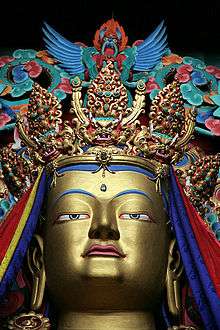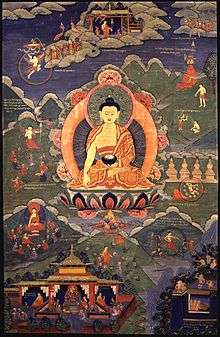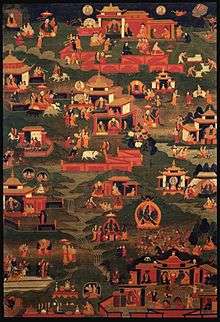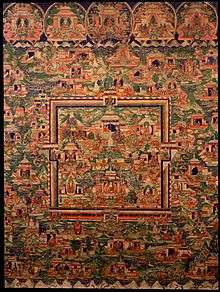Tonpa Shenrab Miwoche
Tonpa Shenrab (Tibetan: སྟོན་པོ་གཤེན་རབ་མི་བོ་ཆེ།, Wylie: ston pa gshen rab "Teacher Shenrab") or Shenrab Miwo (Wylie: gshen rab mi bo )—also called the Buddha Shenrab, Guru Shenrab and a number of other titles—is the legendary founder of the Bon tradition of Tibet.
[Shenrab Miwo] occupies a position very similar to that of Śākyamuni in Buddhism, but... we have no available [or pre-10th century] sources with which to establish his historicity, his dates, his racial origin, his activities, and the authenticity of the enormous number of books either attributed directly to him or believed to be his word."[1]




The story of Tonpa Shenrab was revealed in a fourteenth century terma of Loden Nyingpo.[2]
Etymology
The name Shenrab Miwo is in the Zhang-Zhung language, which is a relative of Old Tibetan; while many suggestions have been put forward as to its meaning, it appears to be the Zhangzhung word "bodhisattva" (equivalent to Tibetan shégya sempa, Wylie: shes rgya sems dpa' ).[3]
Shenrab's life according to Bon traditions
According to Bon doctrine, Tonpa Shenrab and lived 18,000 years ago, predating Gautama Buddha.[4] Practitioners of Bon believe that he first studied the Bon doctrine in Tagzig Olmo Lung Ring, at the end of which he pledged to Shenlha Okar, the god of compassion, that he would guide the peoples of this world to liberation.
Like Gautama, Tönpa Shenrab was of royal birth. Tonpa Shenrab renounced his royal inheritance at the age of thirty-one to travel the path to enlightenment. Tonpa Shenrab embraced the life of a renunciate and commenced austerities, spreading the doctrine of Bon; at length, he arrived in the land of Zhangzhung near what is widely held to be Mount Kailash.
Accounts of Tonpa Shenrab's life are to be found in three principal sources, the Dodü (Wylie: mdo 'dus ), Zermik (Wylie: gzer mig ), and Ziji (Wylie: gzi brjid ). The first and second of the accounts are held to be terma discovered by tertön in the 10th or 11th century; the third is part of the oral lineage (Wylie: snyan brgyud ) transmitted from teacher to disciple.
The Four Portals and the Fifth, the Treasury
The doctrines taught by Tönpa Shenrab are generally classified variously, two being most common. In the first, The Four Portals and the Fifth, the Treasury (sgo bzhi mdzod lnga), the:
- White Water (chab dkar) relates esoteric matters;
- Black Water (chab nag) concerns narratives, magic, funeral rites and ransom rituals;
- Land of Phan ('phan yul) codifies monastic rules and philosophical expositions;
- Divine Guide (dpon gsas) enshrines the Dzogchen teachings; and finally
- Treasury (mtho thog) which serves as an anthology of the salient items of the Four Portals.
The Nine Ways of Bon
The second classification, the Nine Ways of Bon (bon theg pa rim dgu) is as follows—the:
- Way of Prediction (phyva gshen theg pa) codifies ritual, prognostication, sortilege and astrology;
- Way of the Visual World (snang shen theg pa) details the psychophysical Universe;
- Way of Illusion ('phrul gshen theg pa) explains the rites for the dispersal of adverse tulpas, entities and energies;
- Way of Existence (srid gshen theg pa) details funeral and death rituals;
- Way of a Lay Follower (dge bsnyen theg pa) contains the ten principles for wholesome activity;
- Way of a Monk (drang srong theg pa) codifies monastic rules and regulations;
- Way of Primordial Sound (a dkar theg pa) charts the integration of an exalted practitioner into the mandala of highest enlightenment;
- Way of Primordial Shen, (ye gshen theg pa) renders the guidelines for seeking a true tantric master and the commitments (dam tshigs, parallel to the Sanskrit samaya) that bind a disciple to his tantric master; and finally,
- Way of Supreme Natural Condition (bla med theg pa), or The Way of Dzogchen.
The nine ways can also be classified into three groups, the:
- Causal Ways (rgyu'i theg pa) comprises the first four of the above;
- Resultant Ways ('bras bu'i theg pa) includes the fifth through eighth; and
- Unsurpassable Way or the Way of Dzogchen (khyad par chen po'i theg pa or rdzogs pa chen po, abbreviated rdzogs chen) is the ninth.
The Bon Canon
The Bon canon comprises more than two hundred volumes, classified in four categories: the Sutras (mdo), the Perfection of Wisdom Teachings ('bum), the Tantras (rgyud) and Knowledge (mdzod). Besides these, the Bon canon includes material on rituals, arts and crafts, logic, medicine, poetry and narrative. The "Knowledge" section concerning cosmogony and cosmology, though in some respects unique to Bon, shares a more than passing resemblance to Nyingma (rnying ma) doctrines.
Aspects of Shenrab Miwoche
Shenrab Miwoche is said to have three aspects or forms: the tulku (Wylie: sprul sku ) or nirmaṇakāya, Shenrab Miwoche; the dzokku (Wylie: rdzogs sku ) or sambhogakāya, Shenlha Okar and the bönku (Wylie: bon sku ) or dharmakāya, Tapihritsa.[5]
Footnotes
- Karmey, Samten G. (1975). A General Introduction to the History and Doctrines of Bon, pp. 175-176. Memoirs of the Research Department of the Toyo Bunko, No. 33. Tokyo.
- Schaik, Sam van. Tibet: A History. Yale University Press 2011, page 99-100.
- Hummel, Sigbert (1992). "gShen". Bulletin of Tibetology. Gangtok, Sikkim, India: Namgyal Institute of Tibetology. 28 (3): 5–8.
- "Yungdrung Bön". Yeru Bön Center. Retrieved 2019-03-25.
The founder of Bön is Tonpa Shenrab Miwo, who, according to Bön tradition, first brought the Bön teachings to what is now Western Tibet 18,000 years ago.
- The Tibetan for dharmakaya is chos sku in the Buddhist context; though a case can be made that Bon borrowed some, or even much, of its current terminology from Buddhism, to suggest that Sanskrit words are thus the "source" of this terminology is dubious.
References
- Bellezza, John Vincent. (2010). "gShen-rab Myi-bo, His life and times according to Tibet’s earliest literary sources." Revue d’Etudes Tibétaines Number 19 October 2010, pp. 31–118.
- Unknown Author (2005). The Bonpo's Tradition. (Accessed: January 17, 2007).